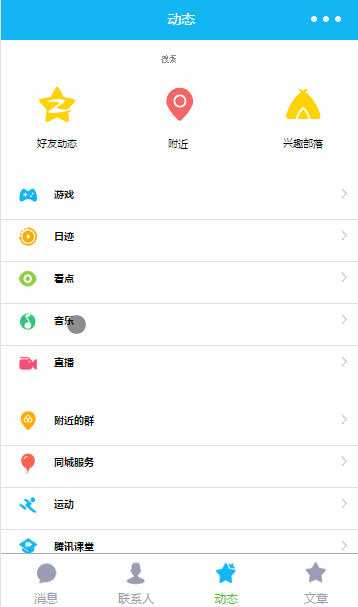
This article mainly introduces the example code of paging loading of WeChat applet. The editor thinks it is quite good, so I will share it with you now and give it as a reference. Let’s follow the editor to take a look.
Organize the documents, search out the code for paged loading of a WeChat applet, and organize and streamline it a little for sharing.
You should encounter the paging loading function frequently, and there are many application scenarios, such as Weibo, QQ, WeChat Moments and news applications, all have the paging loading function, which not only saves us User traffic also improves user experience. So today’s article is to introduce how to implement the page loading function in WeChat applet. As usual, upload the source code and renderings first.
Source code portal

#To implement such a function, you generally need to add the current number of requested pages and the page size when requesting data ( The number displayed on each page) There are also some interfaces that request data through the requested start offset and end offset. For example, if you display 10 pieces of data on one page, the first (first page) request will start with start and end with 0. is 9, the second page is from 10 to 19, and so on.
Since we want to implement the paging loading function, the most important thing is the processing events of pull-down and pull-up. The WeChat applet has helped us encapsulate the trigger events of pull-up and pull-down, as follows
/**
* 页面相关事件处理函数--监听用户下拉动作
*/
onPullDownRefresh: function () {
},
/**
* 页面上拉触底事件的处理函数
*/
onReachBottom: function () {
},Fans who are new to WeChat mini programs may encounter a problem. Why do I rewrite the pull-up and pull-down functions, but why do the functions not call back when I pull up or pull down? ah. Don’t panic, that’s because in addition to rewriting these two functions, we also need to add the following code to the json configuration file
##
{
"enablePullDownRefresh": true
} data: {
page: 1,
pageSize: 30,
hasMoreData: true,
contentlist: [],
}, getMusicInfo: function (message) {
var that = this
var data = {
showapi_appid: '25158',
showapi_sign: 'c0d685445898438f8c12ee8e93c2ee74',
keyword: '我',
page: that.data.page
}
network.requestLoading('https://route.showapi.com/213-1', data, message, function (res) {
console.log(res)
var contentlistTem = that.data.contentlist
if (res.showapi_res_code == 0) {
if (that.data.page == 1) {
contentlistTem = []
}
var contentlist = res.showapi_res_body.pagebean.contentlist
if (contentlist.length < that.data.pageSize) {
that.setData({
contentlist: contentlistTem.concat(contentlist),
hasMoreData: false
})
} else {
that.setData({
contentlist: contentlistTem.concat(contentlist),
hasMoreData: true,
page: that.data.page + 1
})
}
} else {
wx.showToast({
title: res.showapi_res_error,
})
}
}, function (res) {
wx.showToast({
title: '加载数据失败',
})
})
}, onLoad: function (options) {
// 页面初始化 options为页面跳转所带来的参数
var that = this
that.getMusicInfo('正在加载数据...')
}, /**
* 页面相关事件处理函数--监听用户下拉动作
*/
onPullDownRefresh: function () {
this.data.page = 1
this.getMusicInfo('正在刷新数据')
},
/**
* 页面上拉触底事件的处理函数
*/
onReachBottom: function () {
if (this.data.hasMoreData) {
this.getMusicInfo('加载更多数据')
} else {
wx.showToast({
title: '没有更多数据',
})
}
},The above is the detailed content of WeChat Mini Program Paging Loading Case. For more information, please follow other related articles on the PHP Chinese website!
 Mini program path acquisition
Mini program path acquisition
 Win11 skips the tutorial to log in to Microsoft account
Win11 skips the tutorial to log in to Microsoft account
 What does context mean?
What does context mean?
 Where are the number of online viewers at station b?
Where are the number of online viewers at station b?
 What does unsigned integer mean?
What does unsigned integer mean?
 What are the spring frameworks?
What are the spring frameworks?
 bios cannot detect solid state drive
bios cannot detect solid state drive
 The meaning of today's headline display volume
The meaning of today's headline display volume




